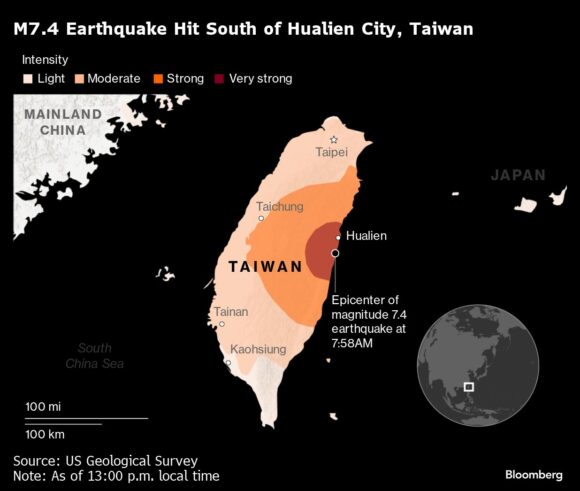Taiwan’s strongest earthquake in a quarter century leveled dozens of buildings on the eastern side of the island, killing at least seven people and disrupting semiconductor production at some of the world’s leading chipmakers.
The quake hit at 7:58 a.m. local time Wednesday and measured 7.4 in magnitude, according to the U.S. Geological Survey, which pinned the epicenter near the eastern city of Hualien. Shocks were felt as far away as Japan and China. At least seven people were killed, 736 were injured and 77 have been trapped, according to Taiwan’s Central Emergency Operation Center. More than two dozen buildings collapsed.
Taiwan weather authorities said it was the biggest seismic event by magnitude to hit Taiwan since 1999, when a 7.7-magnitude quake hit the center of island and killed more than 2,000 people. There have been several aftershocks, mostly clustered on the island’s east coast.
As the dominant producer of the world’s most advanced semiconductors, Taiwan is of paramount importance to the global economy. Any damage from the quake is being closely watched for potential effects on technology output, given the island accounts for more than half of the global market for laptops, motherboards, and network devices.
Its flagship firm Taiwan Semiconductor Manufacturing Co. — the world’s largest contract chipmaker — said following the quake that it had moved some staff out of its production centers. The company, a major supplier of chips to Apple Inc. and Nvidia Corp., is still assessing the impact. All of its staff are safe, a spokeswoman said.

United Microelectronics Corp. said it evacuated some facilities in Hsinchu and Tainan, cities on the western side of Taiwan. The company halted operations of some chipmaking machines, and said it is working to get those machines online again. Acer Inc. Chairman and CEO Jason Chen said there was no material impact on operations.
Market reaction to the quake was fairly muted Wednesday. The benchmark Taiex Index fell as much as 1 percent before paring declines, with losses tracking those of the broader MSCI Asia Pacific Index. Shares in TSMC and UMC dropped around 1 percent or more. The local dollar was stable, trading flat against the greenback.
The quake hit just ahead of the start of a four-day holiday in Taiwan observing Qingming, during which families visit the tombs of their ancestors. Thousands of people normally travel to their hometowns over the period.
Most of the fallout appeared to be concentrated in or near Hualien, a county home to some 300,000 people roughly 200 kilometers southeast of the capital Taipei. The main highway from Hualien to Yilan — a county about halfway to Taipei — was disrupted, the Ministry of Agriculture said, adding that it has begun offering aid to farmers due to the anticipated spike in shipment costs.

Footage from local broadcaster TVBS showed partially collapsed buildings in Hualien City. Taiwan’s official Central News Agency reported that two houses had tilted and people were trapped in the area. Local authorities also announced plans to shut down offices and schools Wednesday.
Aftershocks could also be felt in Taipei, causing buildings to shake. The capital’s metro system resumed operation mid-morning after a brief suspension earlier.
Nuclear power plant operations remained normal and power distribution has been stabilized, according to the island’s power provider. The Civil Aviation Administration said no flights were impacted.
Aftershocks of a magnitude greater than 6 are expected in the following weeks, according to Kuo-Fong Ma, distinguished research fellow at Academia Sinica’s Institute of Earth Sciences in Taiwan. The impact of those shocks is expected to be “moderate” compared to the main event, she said.
The initial quake prompted fears of surging waves in Taiwan and parts of China and Japan. Residents in Japan’s southwestern Okinawa prefecture were urged to evacuate from an expected tsunami as high as 3 meters, according to the Japan Meteorological Agency.
Tsunami warnings were eventually wound back, with the one in Okinawa downgraded to an advisory. Disruptions were still felt in the area, though, with Japan Airlines and All Nippon Airways redirecting flights bound for Okinawa. ANA said it canceled 13 flights affecting more than 2,600 passengers.

The quake was felt in parts of China, including Shanghai and Guangdong, people on the Chinese social platform Weibo said. The world’s second-largest economy shut down some railway tracks in Fujian and Jiangxi provinces, state broadcaster China Central Television reported.
The Chinese government office handling matters related to Taiwan also said it was highly concerned about the earthquake and was willing to offer disaster relief assistance. Beijing claims Taiwan as part of its territory, though the island governs itself as a democracy. Contention over its status is a major geopolitical flashpoint between China and the US.
Top photograph: The Taipei 101 building and other buildings in Taipei, Taiwan. Photo credit: I-Hwa Cheng/Bloomberg





















 Parametric Insurance Meets the Wildfire Peril: InsurTech Kettle Responds
Parametric Insurance Meets the Wildfire Peril: InsurTech Kettle Responds  Mercury Sees Subro, Re Recoveries Cutting Most of $1.6B+ Wildfire Losses
Mercury Sees Subro, Re Recoveries Cutting Most of $1.6B+ Wildfire Losses  LA Fire-Related Capital Hit Prompts State Farm Emergency Rate Request
LA Fire-Related Capital Hit Prompts State Farm Emergency Rate Request  Thirteen U.S. P/C Companies Impaired in 2023: AM Best Report
Thirteen U.S. P/C Companies Impaired in 2023: AM Best Report 




